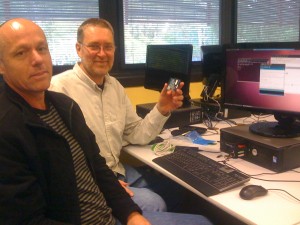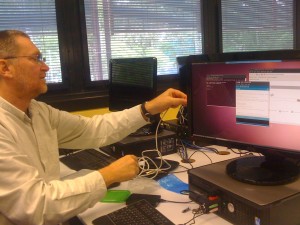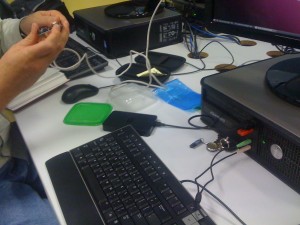http://sxoop.com/twitter/
This tool creates an image of all your twitter followers in a mosaic graphic. Here’s mine:

http://sxoop.com/twitter/
This tool creates an image of all your twitter followers in a mosaic graphic. Here’s mine:
Saw the full potential of the NoteBook software that authors and presents lessons on the SmartBoards. Thankyou Hannah Russell for taking the time to show me how it works. I particularly liked the split screen display of 2 sources, the URL link, the on-screen touch keyboard (like iPad) and the screen capture and paste functions.
Looking forward to hearing how it goes with using Bridgit software to share those lessons in real time with remote students.
Generally, we seem to have ironed out most of the hiccups (mainly linked to people having problems copying the system to Mac formatted disks or by locking the VM system by not shutting it down properly (have to throw out the lock file to restart in those circumstances). Other issues are mainly about the overall technical complexity of having to load up another operating system and then engage with complex set of programming APIs – a real challenge for many of the students.
Been working with Brogan Bunt and Peter Goodall to get an open-source applications pilot up and running. Brogan wants to run his classes in the ITS labs, but with open-source software. The solution has been to install VMWare player in the labs, which allows other operating systems to be used. THen the students bring in a USB specially formatted with Ubuntu (Linux) operating system and a suite of open-source or freeware applications on it. They create a range of sound/media products with them. Then they take it home and use exactly the same software to do their homework and projects. No need for them to purchase expensive proprietory software at home, nor to treck in to uni just to use software. Let’s hope the pilot works well. Cos so far, it sounds fantastic!


 obviously not a ‘new’ technology, but if I had to name the one techi thing that changed life in my corner it was the nifty usb recorder I started using five years ago…. what it means in practice is that the linguistically vulnerable student seeking advice about their writing (those using English as an additional language, for example) can instantly get a copy of the consultation (no cables, just pull it apart, stick it in their laptop) which they can listen to repeatedly at their own pace, and thereby learn so much more than from a single exposure which they may or may not well recall when back at their desk trying to put into practice the pearls of linguistic wisdom showered upon them… their feedback assures me this was the best investment for teaching I ever made…
obviously not a ‘new’ technology, but if I had to name the one techi thing that changed life in my corner it was the nifty usb recorder I started using five years ago…. what it means in practice is that the linguistically vulnerable student seeking advice about their writing (those using English as an additional language, for example) can instantly get a copy of the consultation (no cables, just pull it apart, stick it in their laptop) which they can listen to repeatedly at their own pace, and thereby learn so much more than from a single exposure which they may or may not well recall when back at their desk trying to put into practice the pearls of linguistic wisdom showered upon them… their feedback assures me this was the best investment for teaching I ever made…
Currently there are 3 undergrad classes that I’m aware of that use Ning as an entire learning environment, after a trial use by one class last session.
Ning lets anybody create their own social network and you can have sub-networks or special interest groups inside each network, which usually has a theme. I explored one called “Classroom 2.0”
After navigating thorugh to this network from an “education” themed newtwork i clicked on a network called “Classroom 2.0” and then i clicked on a “visit” link to go there. Once inside (ie on the Classroom 2.0 homepage) it looked remarkably like a WordPress blog. I wondered if it was based on WordPress with some additional code to create a visual clustering and linking between the different sites.
Can anybody comment on what exactly the students like about this particular site/network? How do they use it to stay in touch? Is it particularly easy to link through to find friends’ contributions?
It certainly was easy to set up a new network, see images below you just name and pick a url, theme and colour scheme, and drag and drop the items/features to set the layout.
And here is what it looked like after i’d set it up. Empty. But ready to roll.